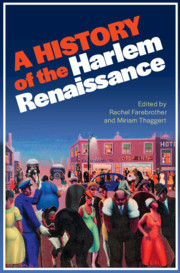Description
A History of the Harlem Renaissance
Coordinators: Farebrother Rachel, Thaggert Miriam
This book presents original essays that explore the eclecticism of Harlem Renaissance literature and culture.
Language: English
Publication date: 02-2021
452 p. · 16.1x23.5 cm · Hardback
452 p. · 16.1x23.5 cm · Hardback
Description
/li>Contents
/li>Biography
/li>
The Harlem Renaissance was the most influential single movement in African American literary history. The movement laid the groundwork for subsequent African American literature, and had an enormous impact on later black literature world-wide. In its attention to a wide range of genres and forms ? from the roman à clef and the bildungsroman, to dance and book illustrations ? this book seeks to encapsulate and analyze the eclecticism of Harlem Renaissance cultural expression. It aims to re-frame conventional ideas of the New Negro movement by presenting new readings of well-studied authors, such as Zora Neale Hurston and Langston Hughes, alongside analysis of topics, authors, and artists that deserve fuller treatment. An authoritative collection on the major writers and issues of the period, A History of the Harlem Renaissance takes stock of nearly a hundred years of scholarship and considers what the future augurs for the study of 'the New Negro'.
Introduction: revising a renaissance Rachel Farebrother and Miriam Thaggert; Part I. Re-reading the New Negro: 1. Cultural nationalism and cosmopolitanism in the Harlem renaissance Daniel G. Williams; 2. Making the slave anew: poetry, history, and the archive in New Negro renaissance poetry Clare Corbould; 3. The New Negro among White Modernists Kathleen Pfeiffer; 4. The Bildungsroman in the Harlem renaissance Mark Whalan; 5. The visual image in New Negro renaissance print culture Caroline Goeser; Part II. Experimenting with the New Negro: 6. Gwendolyn Brooks: riot after the New Negro Renaissance Sonya Posmentier; 7. Romans à clef of the Harlem renaissance Sinéad Moynihan; 8. Modernist biography and the question of manhood: Eslanda Goode Robeson's Paul Robeson, Negro Fionnghuala Sweeney; 9. Modernism and women poets of the Harlem renaissance Maureen Honey; 10. Children's Literature of the Harlem Renaissance Katharine Capshaw; Part III. Re-mapping the New Negro: 11. London, New York, and the Black Bolshevik renaissance: radical black internationalism during the New Negro renaissance James Smethurst; 12. Island relations, continental visions, and graphic networks Jak Peake; 13. 'Symbols from within': charting the nation's regions in James Weldon Johnson's God's trombones Noelle Morrissette; 14. Rudolph Fisher: renaissance man and Harlem's interpreter Jonathan Munby; Part IV. Performing the New Negro: 15. Zora Neale Hurston's early plays Mariel Rodney; 16. Zora Neale Hurston, film, and ethnography Hannah Durkin; 17. The pulse of Harlem: African-American music and the New Negro revival Andrew Warnes; 18. The figure of the child dancer in Harlem renaissance literature and visual culture Rachel Farebrother; 19. Jazz and the Harlem renaissance Wendy Martin; 20. Alain Locke and the value of the Harlem: from racial axiology to the axiology of race Shane Vogel; Afterword Deborah E. McDowell.
Rachel Farebrother is Senior Lecturer in American Studies at Swansea University. She is the author of The Collage Aesthetic in the Harlem Renaissance (2009), which was awarded honourable mention in the 2010 British Association of American Studies book prize. Her essays have appeared in Journal of American Studies, MELUS, and Modernism/Modernity and various edited collections including Fionnghuala Sweeney and Kate Marsh's Afromodernisms: Paris, Harlem, and the Avant-Garde (2013) and Peter Brooker and Andrew Thacker's The Oxford Cultural and Critical History of Modernist Magazines: Volume II, North America (2012).
Miriam Thaggert is Associate Professor of English, Department of English, SUNY-Buffalo. She is the author of Images of Black Modernism: Verbal and Visual Strategies of the Harlem Renaissance (2010). Her essays have appeared in African American Review, American Quarterly, American Literary History, Feminist Modernist Studies, and Meridians. Her second book is a social and literary history of African American women and the railroad in American culture in the nineteenth and early twentieth centuries.
Miriam Thaggert is Associate Professor of English, Department of English, SUNY-Buffalo. She is the author of Images of Black Modernism: Verbal and Visual Strategies of the Harlem Renaissance (2010). Her essays have appeared in African American Review, American Quarterly, American Literary History, Feminist Modernist Studies, and Meridians. Her second book is a social and literary history of African American women and the railroad in American culture in the nineteenth and early twentieth centuries.
© 2024 LAVOISIER S.A.S.





